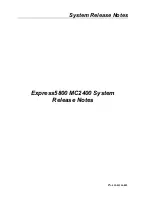
ASM provides storage-management services for the following applications:
Table 17 Software support
See “
Using the Host an Exchange Storage Group
Wizard
” on page 68.
Microsoft Exchange Server 2003 with SP1 or later
and Exchange Server 2007
See “
Using the Create a Shared Folder
Wizard
” on page 70.
File sharing services on local storage
See “
Using the Host a SQL Server Database
Wizard
” on page 71.
Microsoft SQL Server 2000 with SP4 or later, SQL
Server 2005 with SP2 or later, and SQL Server
2008*
See “
Using the Host a User-Defined Application
Wizard
” on page 74.
User-defined applications
* ASM does not support SQL Server 2008 databases that utilize FILESTREAM data type storage.
Microsoft iSCSI Target and Data Protector Express are required to host application storage and create
backups using ASM. Microsoft iSCSI Target and Data Protector Express come preinstalled on your
HP All-in-One Storage System. A license key is not required for Microsoft iSCSI Target. Your license
key for Data Protector Express comes preinstalled on your HP All-in-One Storage System.
Storage management infrastructure
The purpose of ASM is to simplify storage management, so that you do not need to understand the
complexities of allocating and configuring storage, and hosting application storage on your HP
All-in-One Storage System. ASM handles two types of use models:
• Managing storage for application servers
, page 58
• Managing storage for shared folders
, page 59
Managing storage for application servers
With ASM, you can allocate, configure, and host storage for applications residing on servers that
host Exchange, SQL Server, and user-defined applications using the Host an Exchange Storage Group
Wizard, Host a SQL Server Database Wizard, and Host a User-Defined Application Wizard.
The wizards suggest a default storage size, plus default advanced configuration settings, such as
RAID level, for each application component. You can customize all the defaults to fit your storage
needs. However, the default advanced settings provided for Exchange and SQL Server are based on
HP storage, Exchange, and SQL Server best practices and should generally not be changed.
For application storage, ASM creates an iSCSI LUN on your HP All-in-One Storage System for each
storage group component, database component, or the user-defined application you select to host in
the storage-allocation wizard, and exports it to the application server whose storage will be hosted.
ASM also creates a LUN on your HP All-in-One Storage System to host the storage group component,
database component, or the user-defined application you selected in the storage-allocation wizard.
All storage communication passes through the iSCSI LUN on the application server to the LUN on
your HP All-in-One Storage System. This allows data saved by the application to the iSCSI LUN on
the application server to be automatically saved to your HP All-in-One Storage System instead (see
Figure 16
).
All-in-One Storage Manager
58
Содержание AK373A - StorageWorks All-in-One Storage System 1200r 5.4TB SAS Model NAS Server
Страница 1: ...HP StorageWorks All in One Storage System user guide Part number 440583 006 First edition June 2008 ...
Страница 14: ...14 ...
Страница 34: ...Installing and configuring the server 34 ...
Страница 48: ...Storage system components 48 ...
Страница 56: ...Storage management overview 56 ...
Страница 96: ...Managing data protection 96 ...
Страница 100: ...Managing storage 100 ...
Страница 134: ...System recovery 134 ...
Страница 184: ...Microsoft Services for Network File System MSNFS 184 ...
Страница 198: ...BSMI notice Japanese notice Korean notice A B Class A equipment Class B equipment Regulatory compliance and safety 198 ...
Страница 216: ...Index 216 ...
















































